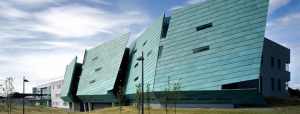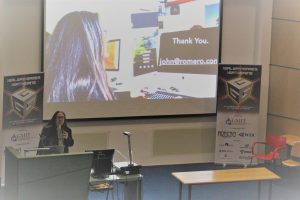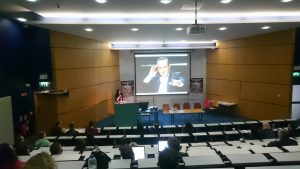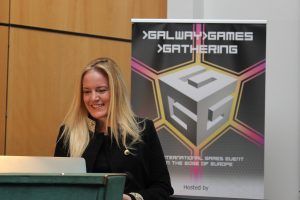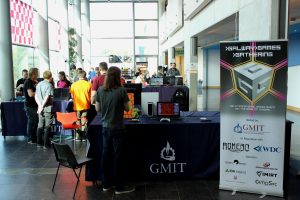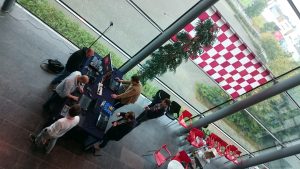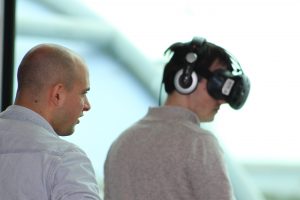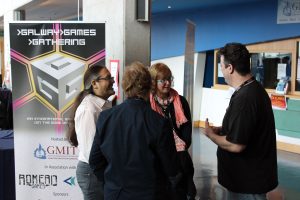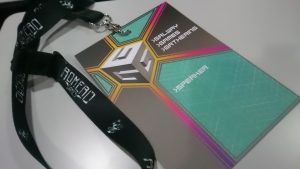The inaugural Galway Games Gathering took place on the 15th and 16th September at the wonderfully designed Galway, Mayo Institute of Technology (GMIT) in Galway (see pic above), featuring a series of 20 presentations from speakers in the Irish and International games communities and an expo of Irish indie games.
The event opened early Saturday with John Romero of Romero Games, who spoke about his life in games, telling the story of the industry through his own story as a developer. His presentation covered his well-known accomplishments such as Commander Keen and Doom, as well as lesser known periods of his life, such as his exposure to games as a child visiting Sierra College near to where he grew up, or his co-founding Loot Drop. At each phase, John spoke about his work within the larger context of what was happening in the games industry as a whole at the time, and closed by drawing our attention to some patters he has seen in the industry, including a return to digital distribution originally seen in the era of early BBS, and a resurgence of e-sports, which have transitioned from arcade championships to large-scale stadium events.
Colm Larkin, creator of Guild of Dungeoneering, was up next. He spoke about the positive impact that sharing an “embarrassingly early” version of his game had on the development process. In particular, he advised developers to not let the fear of their ideas being stolen stop them from sharing, saying that the idea itself isn’t what’s special, it’s the iterations on it that make it so.
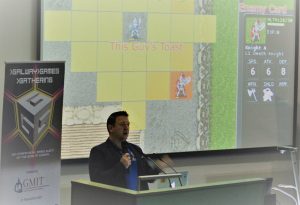 Colm Larkin in his speaking jacket!. Photo by Jacinta Moore
Colm Larkin in his speaking jacket!. Photo by Jacinta Moore
Anna Jenelius from Stockholm Sweden founded her own company, Talecore Studios, in 2015. She spoke about our responsibility to do something positive with our games, noting that while there is nothing wrong with mainstream games, we can do much more with the stories that we tell and the players that we reach. [See her Gamastura posts and her own website].
Paul Conway of Spooky Doorway gave a Post-Mortem of ‘The Darkside Detective‘, walking attendees through the 2.5 year process of creating and releasing a successful indie title with a team of five people and no budget.
Neil Homes spoke about self-publishing and presented ID@Xbox as an platform for indie publishers, specifically highlighting the importance of timing the release of an indie game to not be overshadowed by AAA titles. Om Tandon, UX director at Digit Games in Dublin, spoke about how applying the correct UX methodology to a F2P app increased participation in events by 300%.
 John Romero introduces Om Tandon. Photo by Jacinta Moore
John Romero introduces Om Tandon. Photo by Jacinta Moore
Elaine Reynolds started out as an intern at Starcave in Galway. Today she has her own company, Simteractive, based in Dublin, and she spoke about how she has used psychology in game development, while Dario D’Ambra presented the work he has been undertaking in working on the game “Don’t Make Love”, exploring romance through meaningful conversations in which the player is a participant. Afterward, Liz Mercuri explained the use of Unity to create procedural camera rigs and gameplay cutscenes.
Brett Douville, the lead programmer on Skyrim and Fallout 4, made his first trip to Ireland to give Saturday’s final presentation. Brett spoke about useful tensions in game development, outlining ways in which project managers can subtly shape productive tensions within or between teams, such as by occasionally pushing individuals slightly beyond the limits of what they think they can accomplish, by pitting teams against one another in friendly implied competition, or even by intentionally delaying a feature to force the team to develop creative solutions. Brett also warned against unhealthy tensions, such as long hours and work crunches, and highlighted the importance of a manager’s awareness of the physical, mental, and emotional health of members of a team. [See his games blog and see an interview here.]
DAY 2
Following a reception in the city on Sat. evening everyone was back out nice and early for a full day of talks on Sunday.
Sunday was kicked off by Stephen O’Callaghan, the head of Sound, Tools, and Technology at Sony Interactive Entertainment Europe, who spoke about unlocking the creative potential of teams and individuals. He illuminated some of the ways in which Sony’s Creative Services Group emphasise and explore creativity, noting that an environment of creativity requires three things: building connections, facilitating discovery, and nurturing curiosity.
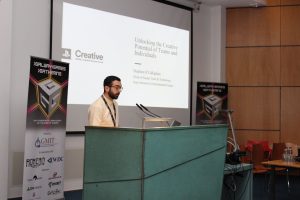 Stephen O’Callaghan (Sony Interactive Entertainment Europe) : Photo by Jacinta Moore
Stephen O’Callaghan (Sony Interactive Entertainment Europe) : Photo by Jacinta Moore
Elisabeth Sampat spoke about her ethical free-to-play philosophy, highlighting four emotions that monetise: Curiosity, Frustration, Amusement, and Desire. Most important of all, however, Elisabeth noted, is generosity: transactions should be designed for value, not addiction. [See her GDC 2017 talk here and her 2017 book Empathy Engines: Design Games that are Personal Political and Profound]
Gd.ie’s own Aphra Kerr spoke of how gamedevelopers.ie emerged at the same time as Nokia’s N-Gage mobile device and then looked at some early games developed in Ireland. Bringing things right up to date she introduced her new book, Global Games, and drew attention to some recurring patterns —such as the return to small development teams—and the emergence of new game making locations, including China, Finland, Sweden, and Poland. This point to lots of potential for indie game devs based in Ireland.
Keith O’Connor, the CTO at Romero games, presented a Junior Coder Survival Guide, emphasising that good code is simple, maintainable, debuggable, and stable, after which Pete McNally, the Technical Art Lead at Havok, showed how to perform 3D Scanning for Games on a Budget.
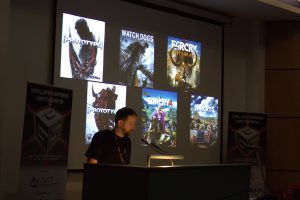 Keith O’Connor (Romero Games) – Photo by Jacinta Moore.
Keith O’Connor (Romero Games) – Photo by Jacinta Moore.
Craig Stuart Garfinkle spoke about writing memorable game music, stating that the secret is a balance between novelty and familiarity. He demonstrated some using his current composing setup: an octave-and-a-half keyboard, his laptop, and a 13TB HDD of samples.
Kevin Murphy presented some bold ideas for alternate payment models of the future, ranging from paid virtual experience to selling virtual real estate in games and monetising FPS games the way others monetise paintball: by selling the ammunition.
Mike Bithell, creator of ‘Thomas Was Alone’, gave an honest (and at times side-splittingly funny) list of 20 tricks that developers can do to improve their games, 10 for games that are already in development and 10 for projects that have not been started yet. Mike was followed by Denman Rooke, who hosted a live digital painting session while sharing some industry tips and techniques.
The final speaker of the event was composer and conductor Eimear Noone, who showcased some of her recent undertakings, and who highlighted the things that are possible when the community is engaged, such as the fan-created orchestra performance of “Malach: Angel Messenger” at iDiG 2017 and the recently released “The Celtic Link”, which is a collection of music from The Legend of Zelda series performed by the DIT Irish Traditional Music Ensemble. [Listen back to her talk from Inspirefest 2017 in Dublin earlier in the year.]
Along with the excellent set of speakers, the indie games expo showcased some of the exciting game development that is happening across Ireland.
Exhibitors were also judged by a panel selected from among the organisers and guests, and a number of awards were given:
Best Game: Final Horizon
Excellence in Design: Sub-Species
Excellence in Art: Jennifer Wilde
Excellence in Audio: Dark Side Detective
Excellence in Narrative: Dark Side Detective
Best Multiplayer Game: Trash Team Racing
Best Student Game: I Dare You
People’s Choice: Licky The Lucky Lizard
Overall, the first Galway Games Gathering was a rousing success. With so many events centred on Dublin, it is exciting to know that a new annual event on Ireland’s western coast has garnered so much attention and support. Here’s to next year’s Gathering!
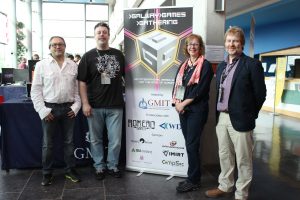
L-r: John Romeo- Romero Games, Manus Burke – Howling Hamster Games, Geraldine McLoughlin – Western Development Commission, Patrick Tobin – GMIT.
Write up: Joshua D Savage, PhD student, Maynooth University and Aphra Kerr, gd.ie & Maynooth University.
Photos: Mostly by Jacinta Moore unless noted as Aphra.
Thanks to Manus Burke, of Howling Hamster Games, for forwarding on the pics and all his work on the event.

